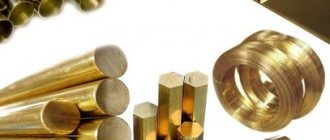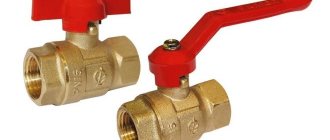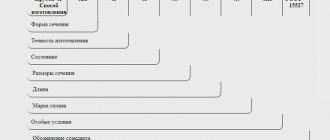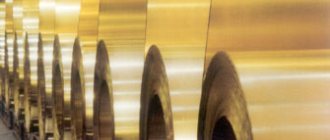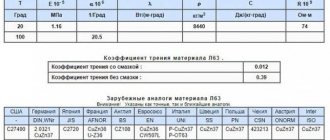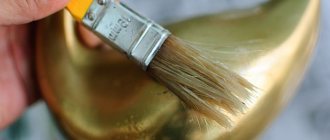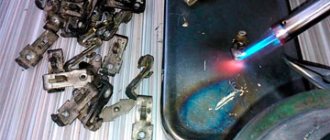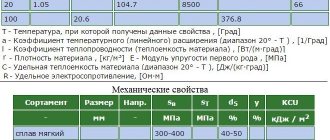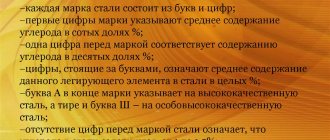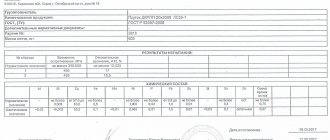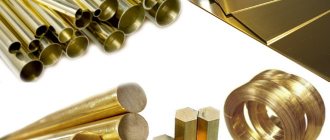Brass LS59-1 is a multicomponent copper alloy, the chemical composition of which is specified by GOST 15527-2004. This GOST indicates that such an alloy may contain 57–60% copper, 37.05–42.2% zinc and 0.8–1.9% lead. Other chemical elements present in the LS59-1 alloy as impurities may be contained in it in an amount of no more than 0.75%.
Brass ingots brand L59-1 are intended for subsequent processing
Although the alloy of this brand belongs to the category of brass, which is well processed by pressure, most often products made from it are processed on high-speed metal-cutting machines. Because of this, LS59-1 is also classified as an automatic weapon. The characteristics of brass of this brand are determined by lead, which is included in its composition as an alloying element.
You can familiarize yourself with the GOST requirements for brass alloys by downloading the document in pdf format from the link below.
GOST 15527-2004 Copper-zinc (brass) alloys processed by pressure. Stamps
Mechanical characteristics
Due to the presence of lead in the composition of LS59-1 brass, when processing products made from it by cutting, small chips are formed, which allows such processing to be performed at high speeds. A distinctive feature of the alloy in question is that lead constitutes a separate phase in its internal structure. This makes such a material highly susceptible to plastic deformation. Meanwhile, if we compare LS59-1 brass with two-component alloys, it is significantly inferior to them in its ductility, so it is better to process such material by cutting.
The range of products made from LS59-1 brass includes:
- rods with different cross-section profiles;
- sheet material – strips, sheets, plates;
- wire;
- profile rolled products;
- pipe products.
Main characteristics of L59-1 brass
Brass of the LS59-1 brand is distinguished by good anti-friction characteristics, which allows the use of such material for the manufacture of products operated in conditions of high friction. From this alloy, in particular, sliding bearings are produced, used to complete various mechanisms and machines. In addition, the abrasion resistance that LS59-1 is characterized by allows this brass to be used for the manufacture of guides for machine tools for various purposes.
Technological properties of alloy L59-1
Since brass of this brand has a multiphase structure, products made from it are characterized by increased fragility. Parts made from LS59-1, on which surface cuts are made, cannot be used as load-bearing elements, since they can break under significant pressure. In addition, the increased fragility of this brass leads to the fact that when exposed to shock loads, the surface of products made of this material can become covered with cracks, which does not allow them to be processed using such a technological operation as forging.
Decoding the brand of alloy LS59-1 and its characteristics
The LS59-1 brand is deciphered as follows: LS - lead brass, in which the percentage of copper is up to 60%. The alloy also contains iron, phosphorus, antimony, and bismuth. Brass chemical composition is regulated by GOST 15527-2004. Compliance with established standards allows us to produce high-quality and durable alloy LS59-1, which has the following technical characteristics:
- Electrical and thermal conductivity;
- resistance to abrasion and corrosion processes;
- anti-friction qualities;
- the ability to process material on cutting machines;
- specific electrical resistivity.
Despite its resistance to deformation and excellent performance, LS59-1 brass is a brittle material. Increased pressure on the metal product can cause fractures at bends or cuts. That is why this alloy is not recommended for use in load-bearing structures and products that will be subject to heavy loads.
The cost of rolled brass is not high, which allows it to be used for the production of various structures and spare parts.
Corrosion resistance
Due to the presence of lead in the chemical composition of brass of the brand in question, a separate phase is formed in its internal structure, which has a positive effect not only on its workability, but also on its resistance to corrosion. Compared to other brass alloys, LS59-1 is more resistant to corrosion. Products made from such brass are not subject to cracking and oxidation when used in conditions of high humidity and temperature changes.
However, there is no need to talk about the exceptionally high corrosion resistance of LS59-1: in this parameter, this alloy is similar to brasses of other brands. In particular, it is not recommended to use it in cases where it will come into contact with products made of iron, aluminum and zinc. In addition, the corrosion resistance of LS59-1 will be poor when:
- simultaneous exposure to high humidity and high pressure;
- contact with fatty acids;
- operation in hydrogen sulfide environment;
- contact with ore waters and mineral acids;
- constant interaction with oxidized solutions and chlorides.
The characteristics of brass allow the metal to be used for the production of shut-off and connecting valves operated at temperatures above 100 degrees
LS59-1 demonstrates its corrosion resistance well under the following operating conditions:
- atmospheric air, including that saturated with sea salt vapor;
- dry steam;
- liquid medium characterized by a very low content of salts and acids;
- freon, alcohol solutions and antifreeze;
- salty sea water in a sedentary state.
It should be borne in mind that the interaction of LS59-1 brass with a gaseous or liquid medium characterized by a high content of ammonia, oxygen and carbon dioxide has a very negative effect on the corrosion resistance of the alloy.
Assortment of brass LS59-1
| Brass bushing LS59-1 | Size 50-1000 mm, price - check |
| Brass square LS59-1 | Side 5-60 mm, matte, semi-hard, price from 389 rub./kg |
| Brass circle LS59-1 | Diameter 3-160 mm, drawn and pressed, matte, price from 360 rub./kg |
| Brass tape LS59-1 | Thickness 0.1-2 mm, cotton, price - check |
| Brass sheet LS59-1 | Thickness 0.5-25 mm, cold-stained and hot-stained, matte, price from 489 RUR/kg |
| Brass wire LS59-1 | Diameter 0.8-6 mm, drawn, price from 575 RUR/kg |
| Brass pipe LS59-1 | Diameter 5-200 mm, drawn and pressed, price - check |
| Brass hexagon LS59-1 | Diameter 5-41 mm, stretched, matte, semi-solid, price from RUB 363/kg |
The sizes and prices of LS59-1 brand products are constantly updated, so contact our managers to quickly and correctly place your order.
Rental products
Various rolled metal products are manufactured from the brass of the brand in question, the requirements for the chemical composition and mechanical characteristics of which are specified by GOST 15527-2004. The range and parameters of the latter are regulated by other regulatory documents. Pipes for the manufacture of which this alloy is used can be produced either by plastic deformation or by continuous casting. At the same time, the production of pipes from brass LS59-1 by casting is much cheaper than the production of similar products obtained using deformation processes.
Brass pipe is easy to install by welding or soldering
The plastic deformation method for brass of this grade is used in the production of wire and rods, which can have a round, hexagonal or square cross-section. In this case, the manufacturing material itself must also meet the requirements established by GOST 15527-2004 (for products that are made from it, the standards are specified by GOST 1066).
Sheets are produced from LS59-1 brass, characterized by high density, hardness and, accordingly, wear resistance. Due to their characteristics, they are successfully used in the manufacture of guide machines for various purposes. In addition, special technologies make it possible to produce soft, semi-hard and hard sheet materials from such brass. In this case, both the density and specific gravity of such products will correspond to similar parameters of the source material.
Brass sheets are used to make plumbing and electrical products, cladding panels and signs
Rods with different cross-sectional shapes made from LS59-1 brass are very actively used in industry. Their distinctive features are high strength and good machinability. It is also important that the production of such products (for this purpose, rolling or drawing technology can be used) is characterized by low cost. Depending on the manufacturing technology and scope of use, rods made of LS59-1 brass can be produced in soft, semi-hard or hard versions.
Mechanical properties of L59-1 brass rods
2a Normative references
GOST 1652.1-77 (ISO 1554-76) Copper-zinc alloys. Methods for determination of copper GOST 1652.2-77 (ISO 4749-84) Copper-zinc alloys. Methods for determination of lead GOST 1652.3-77 (ISO 1812-76, ISO 4748-84) Copper-zinc alloys. Methods for determining iron GOST 1652.4-77 Copper-zinc alloys. Methods for determining manganese GOST 1652.5-77 (ISO 4751-84) Copper-zinc alloys. Methods for determining tin GOST 1652.6-77 Copper-zinc alloys. Methods for determining antimony GOST 1652.7-77 Copper-zinc alloys. Methods for determining bismuth GOST 1652.8-77 Copper-zinc alloys. Methods for determination of arsenic GOST 1652.9-77 (ISO 7266-84) Copper-zinc alloys. Methods for determining sulfur GOST 1652.10-77 Copper-zinc alloys. Methods for determining aluminum GOST 1652.11-77 Copper-zinc alloys. Methods for determining nickel GOST 1652.12-77 Copper-zinc alloys. Methods for determining silicon GOST 1652.13-77 Copper-zinc alloys. Methods for determining phosphorus GOST 9716.1-79 Copper-zinc alloys. Method of spectral analysis using metal standard samples with photographic recording of the spectrum GOST 9716.2-79 Copper-zinc alloys. Method of spectral analysis using metal standard samples with photoelectric recording of the spectrum GOST 9716.3-79 Copper-zinc alloys. Method of spectral analysis of oxide samples with photographic recording of the spectrum
GOST 24978-91 (ISO 4740-85) Copper-zinc alloys. Methods for determining zinc GOST 25086-87 Non-ferrous metals and their alloys. General requirements for methods of analysis ST SEV 543-77 Numbers. Recording and rounding rules. Section 2a. (Introduced additionally, Amendment No. 1).
Areas of use
The wide range of applications of products made from LS59-1 brass is explained by such characteristics as:
- low cost;
- high hardness and strength;
- good machinability;
- wear resistance and corrosion resistance.
All this allows this alloy to be successfully used for manufacturing:
- elements of gear and worm connections;
- bushings and liners for various purposes;
- fastening elements;
- pipe products.
Assortment of brass LS59-1
| Brass bushing LS59-1 | Size 50-1000 mm, price - check |
| Brass square LS59-1 | Side 5-60 mm, matte, semi-hard, price from 389 rub./kg |
| Brass circle LS59-1 | Diameter 3-160 mm, drawn and pressed, matte, price from 360 rub./kg |
| Brass tape LS59-1 | Thickness 0.1-2 mm, cotton, price - check |
| Brass sheet LS59-1 | Thickness 0.5-25 mm, cold-stained and hot-stained, matte, price from 489 RUR/kg |
| Brass wire LS59-1 | Diameter 0.8-6 mm, drawn, price from 575 RUR/kg |
| Brass pipe LS59-1 | Diameter 5-200 mm, drawn and pressed, price - check |
| Brass hexagon LS59-1 | Diameter 5-41 mm, stretched, matte, semi-solid, price from RUB 363/kg |
The sizes and prices of LS59-1 brand products are constantly updated, so contact our managers to quickly and correctly place your order.
Mechanical properties
The mechanical properties of brasses are determined by the properties of the phases, chemical composition and structure. The strength of brass increases with increasing zinc concentration. The density reaches the maximum value of the two-phase region α+β at 45...47% zinc. When the β' phase completely replaces the α phase, the strength of brass quickly decreases due to the high brittleness of the β' phase. An increase in the amount of zinc reduces the normal elastic modulus E. When the zinc content exceeds the solubility limit in the α-phase, the β'-phase is released in the alloy structure, which sharply reduces the elastic modulus. β-brasses with a β'-structure have low plasticity at room temperature. Copper alloys with a zinc content of more than 50% are not subject to cold deformation, therefore α and α+β-brasses are used in production, and β-brasses are used for special applications, for example, as the basis of shape memory alloys.
Thermal conductivity λ and ω electrical conductivity of copper decreases when alloyed with zinc, and when its concentration in brass is more than 20%, thermal conductivity λ and ω electrical conductivity of copper is no more than 40% of the corresponding characteristics of copper.
Single-phase brasses after annealing in a soft state have σв = 24–38 kgf/mm2 and δ = 45–60%, and two-phase brasses have σв = 35–45 kgf/mm2 and δ = 33–65%. The strength and hardness of brasses is significantly increased by cold plastic deformation to σв = 42–75 kgf/mm2, while the plasticity sharply decreases δ = 3–10%.
Corrosive properties
Brasses have good corrosion resistance in urban and rural environments, as well as in marine climates. Brasses containing less than 15% Zn are close in corrosion resistance to industrial-grade copper. The corrosion rate of brass in atmospheric conditions does not exceed 0.001 mm/year.
The corrosion rate of brass in fresh water is insignificant, and at a temperature of 20°C it is 0.0025-0.025 mm/year. Brasses have good corrosion resistance to soil and are neutral to food products.
Under the influence of mineral acids (nitric, hydrochloric), brass intensively corrodes. Sulfuric acid acts on brass much more slowly, however, in the presence of oxidizing agents K2Cr2O7, Fe2(S04)3, the corrosion rate increases by two orders of magnitude. Brasses are very stable in alkali solutions (with the exception of ammonia) and in concentrated solutions of neutral salts.
